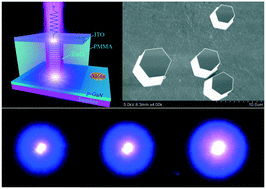Vertically-aligned ZnO microrod for high-brightness light source†
Abstract
Compared with conventional planar structures, semiconductor micro/nanostructures have attracted great attention for the fabrication of monolithically integrated, high-brightness and high-efficiency light-emitting diodes and lasers, due to their natural microresonators and superior gain properties. In the present study, vertically well-aligned ZnO microrod arrays were grown on a p-GaN template via a catalyst-free, vapor–solid process. The prismatic microrod, a high-quality, hexagon-shaped and well-defined geometric construction, can act as a microresonator, for example with the occurrence of a whispering gallery mode (WGM) lasing action in the ultraviolet region. Meanwhile, the prismatic ZnO microrods/p-GaN heterostructure was utilized to construct light-emitting devices, yielding a diode-like rectification behavior and near-ultraviolet electroluminescence (EL) centered at 397 nm. Moreover, a heterojunction diode involving a single prismatic ZnO microrod grown on a p-GaN template was illuminated electrically, with each rod employed as a light source. Interestingly, the EL spectra of the vertical microrod-diode with spectrally good separation can be assigned to exciton-polariton features by virtue of the waveguide properties and optical confinement. The experimental findings provide a very promising candidate for the realization of superluminescent exciton-polariton light-emitting diodes and microlasers.



 Please wait while we load your content...
Please wait while we load your content...